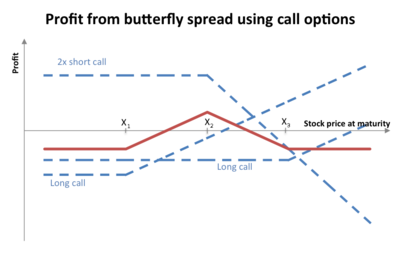| Revision as of 13:31, 10 June 2020 editJzG (talk | contribs)Edit filter managers, Autopatrolled, Extended confirmed users, Page movers, New page reviewers, Pending changes reviewers, Rollbackers155,077 editsm →References: Removing blacklisted .xyz domain (likely spam)Tag: AWB← Previous edit | Revision as of 00:59, 18 January 2021 edit undoMrOllie (talk | contribs)Extended confirmed users, Pending changes reviewers, Rollbackers236,785 edits →Butterfly P/L graph: rm poorly done 'example' / product placement spam imageTag: Visual editNext edit → | ||
| Line 33: | Line 33: | ||
| A short butterfly options strategy consists of the same options as a long butterfly. However now the middle strike option position is a long position and the upper and lower strike option positions are short. | A short butterfly options strategy consists of the same options as a long butterfly. However now the middle strike option position is a long position and the upper and lower strike option positions are short. | ||
| == Butterfly P/L graph == | |||
| Since the butterfly options strategy is a complex one and contains 3 "legs" (options with 3 different strike), its P/L graph is quite complicated and changes considerably as time moves forward to the expiration. | |||
| This is a graph showing the P/L (profit / loss) for a 1-year butterfly options strategy 5 days before expiry: | |||
| ] | |||
| == Margin requirements == | == Margin requirements == | ||
Revision as of 00:59, 18 January 2021


In finance, a butterfly is a limited risk, non-directional options strategy that is designed to have a high probability of earning a limited profit when the future volatility of the underlying asset is expected to be lower or higher than the implied volatility when long or short respectively.
Long butterfly
A long butterfly position will make profit if the future volatility is lower than the implied volatility.
A long butterfly options strategy consists of the following options:
- Long 1 call with a strike price of (X − a)
- Short 2 calls with a strike price of X
- Long 1 call with a strike price of (X + a)
where X = the spot price (i.e. current market price of underlying) and a > 0.
Using put–call parity a long butterfly can also be created as follows:
- Long 1 put with a strike price of (X + a)
- Short 2 puts with a strike price of X
- Long 1 put with a strike price of (X − a)
where X = the spot price and a > 0.
All the options have the same expiration date.
At expiration the value (but not the profit) of the butterfly will be:
- zero if the price of the underlying is below (X − a) or above (X + a)
- positive if the price of the underlying is between (X - a) and (X + a)
The maximum value occurs at X (see diagram).
Short butterfly
A short butterfly position will make profit if the future volatility is higher than the implied volatility.
A short butterfly options strategy consists of the same options as a long butterfly. However now the middle strike option position is a long position and the upper and lower strike option positions are short.
Margin requirements
Margin requirements for all options positions, including a butterfly, are governed by what is known as Regulation T. However brokers are permitted to apply more stringent margin requirements than the regulations.
Butterfly variations
- The double option position in the middle is called the body, while the two other positions are called the wings.
- The option strategy where the middle options (the body) have different strike prices is known as a Condor.
- In case the distance between middle strike price and strikes above and below is unequal, such position is referred to as "broken wings" butterfly.
References
- McMillan, Lawrence G. (2002). Options as a Strategic Investment (4th ed.). New York : New York Institute of Finance. ISBN 0-7352-0197-8.
- Credit By Brokers And Dealers (Regulation T), FINRA, 1986